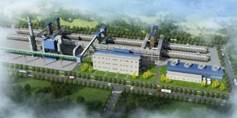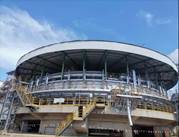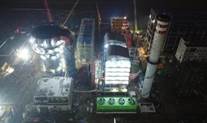Specialised Topic: CISDI Thermal Engineering & Environmental Protection breaks new ground in green, low-carbon transformation
Date:2021/10/29 Source: CISDI
This year has seen a major boom in demand for CISDI Thermal Engineering and Environmental Protection Co.’s green, low-carbon developments.
New contract wins have been pouring in.
The company’s new tech, methods and concepts are driving the demand. Innovation-driven developments have been achieved for eco-friendly reheating and heat treatment lines, efficient energy utilisation, solid waste to energy reclamation and air pollution control.
✧ Eco-friendly reheating and heat treatment line
In response to China’s push for higher standards in energy efficiency, pollutant emission, quality and intelligent control at its steel enterprises, CISDI’s specialist company has focussed on developing its zinc, aluminium and magnesium-plated tech and equipment.
These developments further strengthen the expertise it offers to reheating furnace and post-processing businesses.
The company won two historic new contracts in the first half of this year - a colour coating line is to be supplied to China’s Chengdu Plate Mill Co. and a strip heat treatment line is being created for China’s Guangxi Guangsheng High-strength and Wear-resistant Materials Co.
Its 2,050mm continuous high-strength strip heat treatment line is already operating at Baosteel, applying its innovative continuous treatment expertise.
The company is also constructing a reheating furnace for the 2,250mm hot strip rolling line at Guangxi Shenglong Metallurgical Co. It will feature a cold charge-based hourly output of 405 tonnes, the maximum for this type of furnace in China.
✧ Highly-efficient energy utilisation
CISDI’s total solutions for energy recovery, storage and distribution and reutilisation have helped improve performance and competitiveness for clients around the world.
Highlight achievements include the high-pressure POC gas holder, the high-performance, downsized green thermal power plant, and the plant-wide energy smart control system.
In the first half of 2021, major breakthroughs were made in highly-efficient energy utilisation.
Contracts were awarded from:
ü Guigang Steel for an ultra-high-temperature, subcritical power generation plant, along with a BFG holder, to an EPC mode in the Guangxi Province
ü Hongda Steel for an ultra-high-temperature, subcritical gas-fired power generation plant to an EPC mode in the Shanxi Province
ü Anyang Steel for two energy reutilisation upgrades in the Henan Province and its energy management, which was won by a consortium - the first of its kind at CISDI.

Artist’s impression of the coking excess heat power generation project at Anyang Steel’s Zhoukou Plant
✧ Solid and hazardous waste converted to energy
CISDI’s patented rotary hearth furnace expertise and products have resulted in the super-efficient recycling of iron and zinc-bearing solid wastes from steel production procedures. Its technical indicators feature almost 100 per cent of the overall utilisation ratio in iron solid waste, over 75 per cent of the final product metallisation ratio and over 85 per cent of solid waste’s dezincification ratio.
CISDI’s solid waste to energy solutions enabled a steel enterprise to meet its zero iron waste discharge target, advancing the steel sector’s green credentials and WtE industrialisation.
CISDI Thermal Engineering & Environmental Protection has built eight Chinese rotary hearth furnaces and is responsible for the annual treatment and recycling of 1.85 million tonnes of iron and zinc-bearing solid wastes.
The company is now going full-steam ahead with projects at China’s Yanshan Steel, Baosteel Zhanjiang and Shanghai, Shougang Jingtang Steel and Xinyu Steel.
Five rotary hearth furnaces are under construction at China’s Baosteel Wuhan, Zenith Nantong Steel and Donghai Special Steel, plus Vietnam’s Formosa Ha Tinh Steel.
CISDI now ranks as China’s top supplier of rotary hearth furnaces. It is responsible for the majority of the country’s operational and in-process RHFs and has more than 80 per cent of the Chinese market share.
A 250,000-tonne rotary hearth furnace was successfully built by CISDI at Xinyu Steel in the first half of this year.
Every year, 162,000 tonnes of direct reduction iron products will be produced by recovering the plant’s iron solid waste, and 13,000 tonnes of zinc hypoxide will be recovered.
In addition, 164,000 tonnes of steam being produced from the recovery processes will be used to generate electricity. The plant will reap $24.82 million USD in economic returns.
This RHF provides comprehensive solutions for the recycling of all iron and zinc dusts and sludges created by production procedures and means no dust piles to compromise the environment. All the relevant systems are able to return solid waste into the production process.
Xinyu Steel’s zero solid waste discharge performance has become a benchmark contributor for the Jiangxi Province’s circular economies and low-carbon business development.

The CISDI-built rotary hearth furnace at Xinyu Steel, which can treat 250,000 tonnes of iron and zinc waste every year
✧ Air pollutant ultra-low emissions
CISDI has established an integrated air pollutant control technology system, operational from source reduction to process and end-of-pipe treatments.
The treated off-gas contains a dust concentration of less than 10mg/Nm3. Sulphur dioxide concentration is less than 35mg/Nm3 and NOx concentration is less than 50mg/Nm3 - world-class indicators.
The system’s first application was for semi-dry desulphurisation (de-SOx) and denitration (de-NOx) technology at Jinxi Steel’s sintering plant, which is under construction.
CISDI’s de-SOx and de-NOx solutions are also operating successfully, to an EPC mode, for a steel plant’s 450m2 sintering machine in Rizhao City in China’s Shandong Province. This project applied wet desulphurisation, wet electrostatic precipitation and low-temperature selective catalytic reduction de-NOx technologies to control fume from the sintering machine. It also takes measurements to collect the smoke plume for reuse.
Thanks to these pollutant controls, the concentration of particles SOx and NOx in the discharged fume has been reduced to lower than 10mg/m3, 35mg/Nm3 and 50mg/Nm3, reaching the strictest of global emission standards.
As a result, the plant has reduced 800 tonnes of dust emissions, 13,300 tonnes of SOx and 4,000 tonnes of NOx emissions.

The 450m2 sintering machine’s de-SOx and de-NOx units at a Rizhao’s steel plant, built by CISDI, is taking the lead in hitting ultra-low-emissions targets

